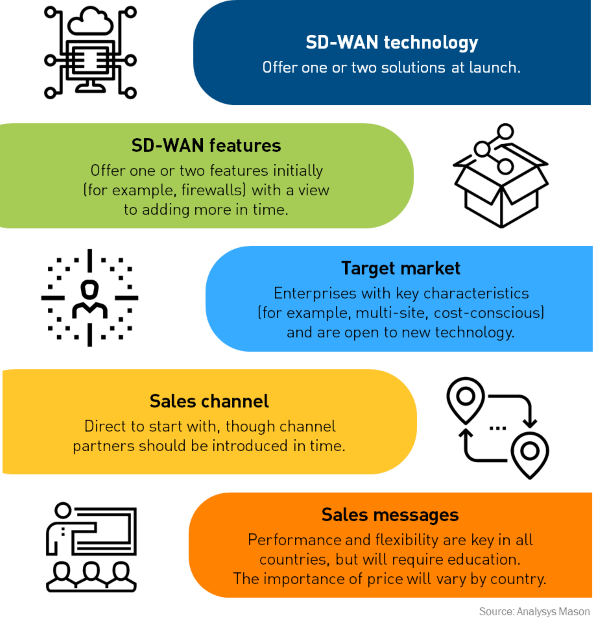Telecoms operators should prioritise the launch of SD-WAN
Listen to or download the associated podcast
Many telecoms operators are postponing the introduction of SD-WAN or are launching it cautiously, primarily because of the perceived risk that it will cannibalise revenue from their existing MPLS services. Analysys Mason believes that delaying the launch of SD-WAN is a mistake because other types of service providers are launching SD-WAN regardless of what telecoms operators are doing. By waiting, telecoms operators risk losing business to more-aggressive competitors and may also miss out on opportunities to learn how best to sell and support SD-WAN. By the time that these operators do add SD-WAN, it may be too late.
This article, which is based on our recently published report How telecoms operators can launch SD-WAN, argues that operators should look to expedite a simple SD-WAN product and use it as a base for adding more features and services – and for generating new revenue streams – over time.
Operators' arguments against launching SD-WAN can be countered
Many of the reasons that explain operators' reluctance to introduce SD-WAN can be countered (see Figure 1).
Figure 1: Arguments and counter-arguments for launching SD-WAN
| Reasons for delaying SD-WAN | Counter-argument | |
|---|---|---|
|
Impact on MPLS revenue |
|
|
|
Weak business case |
|
|
|
Limited demand |
|
|
|
SD-WAN cannot support critical services |
|
|
Source: Analysys Mason
These counter-arguments build an essentially negative case: operators need to launch SD-WAN, and if they do not, other providers will. More-positive reasons for supplying SD-WAN also need consideration. Eventually, SD-WAN could be a platform for providing new revenue-generating services, including security, LAN management, and even IoT services.
Former Harvard Business School professor Clark Gilbert describes how innovation can be framed as a threat, as a way of securing resources, and then as an opportunity once resources are secured.1 The same approach could be used by operators launching SD-WAN.
Operators' initial SD-WAN offers can be simple
Telecoms operators do not need to have a complicated product when they initially launch, and probably should avoid this. Even a relatively simple solution will take many months to develop; providers should avoid additional barriers by making the solution too complex. Figure 2 provides a suggested approach to the launch.
Figure 2: Overview of a suggested initial SD-WAN technology, features, target market and sales strategy

The underlying technology can come from one or two vendors. With limited technology differentiation, there is little need for most service providers to integrate and launch solutions from multiple vendors. The standard features that run on top of SD-WAN can also be limited to a few basic services, such as firewalls. Businesses may value a selection of firewall vendors more than they do a selection of SD-WAN solutions, especially if this allows them to continue their relationships with trusted security suppliers.2
Operators' early efforts to sell SD-WAN can be targeted at specific customers
Operators can simplify the process of selling SD-WAN by targeting a select group of customers. Companies that have multiple sites and meet some of the following criteria are most likely be interested.
- High usage of cloud services
- Cost-conscious
- Likely to add/take down sites
- Sites of varying size.
The retail, finance and insurance, construction and manufacturing sectors are most likely to meet these criteria.
Perhaps equally important is the attitude of a potential customer's organisation to new technology. SD-WAN will initially only be adopted by IT departments that are more open to using new technology, regardless of vertical market or size. SD-WAN is also still viewed as a new and relatively unproven technology by many businesses. Operators can focus their sales resources more effectively by filtering prospects by those open to new technology (for example, companies that adopted the use of cloud early),.
Finally, we recommend that operators focus on direct sales, at least initially. All services providers that use channel partners will want to sell SD-WAN through these channels. However, few have to date. Selling through channel partners can be a longer-term ambition but will be a distraction in the near term.
The risks of being late to the SD-WAN market outweigh those for being too early
SD-WAN will probably become the default technology for connecting wide-area networks (some services providers are already exploring when to stop offering MPLS to new customers). All business-focused operators will need to introduce it at some point, or they will be pushed towards the provision of basic connectivity/wholesale offers, with others commanding the primary customer relationship. Starting early will allow a service provider time to experiment with the technology while the market is developing. Launching late may leave less time and resource to experiment.
More fundamentally, many operators have a problem in how they are perceived by business customers: customers view many operators as expensive, non-responsive and unwilling to innovate. An early introduction of SD-WAN will demonstrate to customers that some of these issues are being addressed, while delaying will do nothing to fix the sense of frustration that customers feel. The risk is that established operators launch late, never catch up their more-ambitious competitors and only add to their reputation for being slow and lacking in innovation.
1 Clark G, Gilbert, Harvard Business School. Can competing frames co-exist? The paradox of threatened response. Available at www.hbs.edu/faculty/Publication%20Files/02-056_e1900597-4a17-41cf-9fc5-7f92f65c07c0.pdf.
2 Multinational corporations (MNCs) and very large enterprises may need more-complex, customised solutions.
Downloads
Article (PDF)Authors

